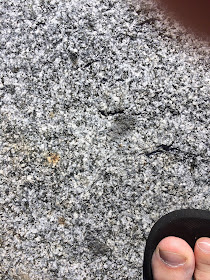 |
| Rockvale Monzogranite and my toes for scale |
The first post I want to do is one about an arsenic mine I visited near Armidale. When I visited the Rockvale Arsenic Mine it was quite evident that the site has contaminated the soil. The most widespread contaminant in the region is antimony metal which when mined (along with gold) in the Hillgrove district and was discharged in large volumes into the Macleay River catchment. This antimony continues to be dissolved in water flowing from the old Hillgrove and other abandoned areas. However, further upstream from Hillgrove, in the Wollomombi River catchment from is Rockvale which has a similar geological history.
 |
| Rockvale Arsenic mine |
 |
| Possible evidence of contaminated soil transport (gully erosion) |
The number of old mines is the Rockvale area is quite significant. Some have been rehabilitated, some badly rehabilitated and others still discharge metal contaminants into the receiving environment. The Rockvale Arsenic mine is a good example, it appears to be the northern most of several mineral deposits that occur along a line a couple of kilometres long, possibly terminating at the Ruby Silver Mine. The main mineral mined from the hillgrove arsenic mine was arsenopyrite, though other less common arsenic minerals were also part of the ore. The arsenic was 'roasted' to drive of volatile elements and concentrate the ore.
The legacy of historical operations can be seen from the photograph which shows extensive bare areas and gully erosion due to the metal toxicity and acid mine waste from oxidised pyrite, arsenopyrite and other sulfide minerals. So, although the metal contamination from downstream Hillgrove is well known, a baseline study will obviously provide some indication that contamination is coming from other upstream sources too. It will be interesting to see how much.
References/bibliography
*Ashley, P. & Graham, B. 2001. Heavy metal loadings of streams in the Macley River catchment. Report to the Mid North Coast Catchment Management Board, NSW Department of Mineral Resouces & Armidale Dumaresq Council.
*Craw, D., Wilson, N. & Ashley, P.M. 2004. Geochemical controls on the environmental mobility of Sb and As at mesothermal antimony and gold deposits. Applied Earth Sciences (Transactions of the Institute of Mining and Metallurgy) vol 133 B3.
*Kent, A.J.R. (1994) Geochronology and geochemistry of Palaeozoic intrusive rocks in the Rockvale region, southern New England Orogen, New South Wales. Australian Journal of Earth Sciences 14:4
*McClatchie & Sylvester. 1970. The Tulloch Silver mine. Records of the Geological Survey of New South Wales. Vol 12, part 1.
Sincere condolences for your sad loss, and good to see you are looking to the future. All the best.
ReplyDeleteThank you Jan for your kind words and thank you for continuing to read my blog.
DeleteThis comment has been removed by the author.
ReplyDeleteHi Candii, I'm afraid that archaeology and indigenous heritage is not a strong point of mine. So, I have my doubts I could help you. Sorry.
DeleteHi Rod,
ReplyDeleteGood to see you getting back into it and good luck with self employment.
Also I hope your little lady is looking over you and your family-- you guys did the very best you could for her.
Heartfelt regards,
Dylan
Cheers, Dylan.
DeleteI appreciate your encouragement.
Hit the Desktop button as I have been doing periodically to find a very welcome return to writing. You have been missed, my very best wishes for your new venture into self employment. It can be hard work and stressful but if it works very rewarding. As well as streamflow monitoring of heavy metal levels I would think some examination for any metal deposition into Stream sediments might also be worth looking into as this would affect Stream biology in several ways.
ReplyDelete